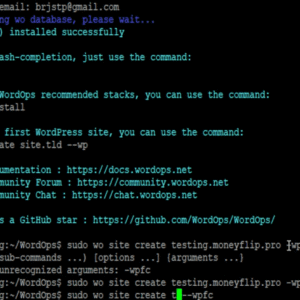Introduction
In the realm of financial web development, implementing robust cryptographic security measures is crucial to safeguard sensitive data, transactions, and user information. This guide provides a detailed walkthrough of practical strategies that web developers can employ to enhance the security of financial web applications.
1. Secure Transaction Protocols
Overview:
Ensuring secure transaction protocols is foundational for financial web applications. This involves implementing cryptographic measures to protect the confidentiality and integrity of financial transactions.
Implementation Steps:
a. Transport Layer Security (TLS): Utilize the latest TLS protocols to encrypt data in transit.
b. Public-Key Cryptography: Implement asymmetric encryption for secure key exchange between parties involved in transactions.
2. Cryptographic Wallet Security
Overview:
Securing cryptocurrency wallets is paramount for protecting users’ digital assets. Employing advanced cryptographic safeguards adds an extra layer of protection.
Implementation Steps:
a. Hierarchical Deterministic Wallets (HD Wallets): Implement HD wallets to enhance security and generate unique addresses for each transaction.
b. Multi-Signature Authentication: Require multiple signatures to authorize transactions, enhancing wallet security.
3. Regulatory Compliance in Crypto-driven Environments
Overview:
Navigating regulatory compliance in crypto-driven environments requires aligning cryptographic practices with legal standards.
Implementation Steps:
a. Know Your Customer (KYC) Protocols: Implement robust KYC protocols using cryptographic identity verification techniques.
b. Smart Contracts for Compliance: Use smart contracts to automate and ensure compliance with regulatory requirements.
4. Smart Contract Security
Overview:
Smart contracts are integral to decentralized applications. Ensuring their security involves implementing cryptographic best practices.
Implementation Steps:
a. Formal Verification: Use formal methods to verify the correctness of smart contract code and identify potential vulnerabilities.
b. Secure Coding Practices: Adhere to secure coding practices, including input validation and protection against common vulnerabilities.
5. Encryption in Transit: Safeguarding Financial Data
Overview:
Securing data during transmission is critical. Employing cryptographic techniques safeguards financial information against interception.
Implementation Steps:
a. SSL/TLS Implementation: Ensure the proper implementation of SSL/TLS protocols to encrypt data during communication.
b. Perfect Forward Secrecy: Implement perfect forward secrecy to protect past and future communications even if private keys are compromised.
6. Quantum-Resistant Cryptography
Overview:
With the advent of quantum computing, adopting quantum-resistant cryptography is crucial for future-proofing financial web applications.
Implementation Steps:
a. Post-Quantum Algorithms: Explore and implement cryptographic algorithms resistant to quantum attacks, such as lattice-based cryptography.
b. Quantum Key Distribution (QKD): Consider implementing QKD for secure key exchange in a quantum-resistant manner.
7. Cryptocurrency Exchange Security
Overview:
Cryptocurrency exchanges are prime targets for cyber threats. Enhancing their security involves cryptographic safeguards.
Implementation Steps:
a. Cold Storage Implementation: Use cold storage solutions and multi-signature wallets to protect users’ funds.
b. Regular Security Audits: Conduct regular security audits with cryptographic experts to identify and address vulnerabilities.
8. Hardware Security Modules (HSMs) Integration
Overview:
Integrating HSMs enhances cryptographic key management and provides an additional layer of protection against key compromise.
Implementation Steps:
a. HSM Deployment: Deploy HSMs to secure cryptographic keys and ensure secure key generation and storage.
b. Usage in Financial Transactions: Implement HSMs in financial transactions to secure sensitive cryptographic operations.
Conclusion
Implementing cryptographic security measures in financial web development is an ongoing process. By following these detailed steps, web developers can create a robust and secure environment for financial transactions, safeguarding user data and digital assets against evolving cyber threats.
9. Cryptographic Innovations on the Horizon
Overview:
Stay ahead of the curve by exploring upcoming cryptographic innovations that have the potential to redefine security standards in financial web development.
Advanced Implementation Strategies:
a. Post-Quantum Cryptography Adoption: Begin researching and testing post-quantum cryptographic algorithms to prepare for the era of quantum computing.
b. Experimenting with Homomorphic Encryption: Explore the applications of homomorphic encryption for secure computation on encrypted data.
10. Cryptocurrency Governance and Cryptographic Security
Overview:
Understand the intersection of cryptocurrency governance and cryptographic security to influence decision-making regarding protocol changes and updates.
Advanced Implementation Strategies:
a. Participation in Governance Protocols: Actively participate in cryptocurrency governance structures to influence security-related decisions.
b. Decentralized Governance Models: Explore the implementation of decentralized governance models that balance security and community involvement.
11. Cross-Chain Interoperability: Cryptographic Challenges and Solutions
Overview:
Address the cryptographic challenges associated with achieving seamless interaction between different blockchain networks in a cross-chain environment.
Advanced Implementation Strategies:
a. Atomic Swaps Implementation: Experiment with atomic swaps to enable secure and trustless transactions across different blockchains.
b. Interoperability Protocols Integration: Explore and implement interoperability protocols that facilitate secure communication between diverse blockchain networks.
Overview:
Maintain a proactive security posture by integrating continuous security audits and threat intelligence into the development lifecycle.
Advanced Implementation Strategies:
a. Automated Security Scanning: Implement automated tools for continuous security scanning to detect vulnerabilities in real-time.
b. Integration with Threat Intelligence Feeds: Incorporate threat intelligence feeds to stay informed about the latest cybersecurity threats and vulnerabilities.
Conclusion
By incorporating these advanced cryptographic strategies, web developers can not only strengthen the security of financial web applications but also adapt to the evolving landscape of cybersecurity. The proactive approach outlined in this guide ensures a resilient defense against sophisticated threats.
Cutting-Edge Cryptographic Practices for Unparalleled Security in Financial Web Development
Introduction
This guide delves into cutting-edge cryptographic practices, equipping web developers with advanced strategies to fortify the security of financial web applications. Stay at the forefront of cybersecurity by implementing these state-of-the-art techniques.
13. Quantum-Safe Cryptography Implementation
Overview:
Prepare for the era of quantum computing by adopting quantum-safe cryptography to safeguard financial systems against quantum threats.
Advanced Implementation Strategies:
a. Experimenting with Quantum Key Distribution (QKD): Explore the use of QKD for secure key distribution, resistant to quantum attacks.
b. Collaboration with Quantum Computing Experts: Engage with experts in quantum computing to assess vulnerabilities and implement quantum-resistant cryptographic solutions.
14. Zero-Knowledge Proofs and Privacy Coins Integration
Overview:
Enhance user privacy in financial transactions by integrating zero-knowledge proofs and privacy coins, leveraging cryptographic techniques for anonymity.
Advanced Implementation Strategies:
a. Implementation of zk-SNARKs: Explore the implementation of zk-SNARKs for zero-knowledge proof construction, ensuring transaction privacy.
b. Integration of Privacy Coins: Investigate the integration of privacy-focused cryptocurrencies like Monero and Zcash for enhanced financial privacy.
15. Homomorphic Encryption for Secure Computation
Overview:
Enable secure computation on encrypted data by implementing homomorphic encryption, allowing financial operations without exposing sensitive information.
Advanced Implementation Strategies:
a. Experimentation with Fully Homomorphic Encryption (FHE): Explore the applications of FHE for performing complex computations on encrypted data.
b. Collaboration with Cryptographic Researchers: Engage with researchers specializing in homomorphic encryption to stay informed about advancements in the field.
16. Blockchain Interoperability Protocols
Overview:
Address the challenges of interoperability in a multi-blockchain environment by implementing advanced blockchain interoperability protocols.
Advanced Implementation Strategies:
a. Research on Cross-Blockchain Communication: Stay updated on research in cross-blockchain communication to implement future-proof interoperability solutions.
b. Contributions to Open-Source Interoperability Projects: Contribute to open-source projects focused on blockchain interoperability to foster collaboration and innovation.
17. Cybersecurity Resilience Testing
Overview:
Ensure the resilience of cryptographic security measures by conducting comprehensive cybersecurity resilience testing on financial web applications.
Advanced Implementation Strategies:
a. Red Team Exercises: Engage in red team exercises to simulate real-world cyber threats and evaluate the effectiveness of security measures.
b. Continuous Evaluation of Incident Response Plans: Regularly assess and refine incident response plans to enhance the organization’s ability to respond to security incidents.
Conclusion
By embracing these cutting-edge cryptographic practices, web developers can elevate the security posture of financial web applications to unprecedented levels. These advanced strategies empower development teams to anticipate and counteract emerging threats effectively.
Integrating Advanced Security Measures into Financial Web Development
Introduction
In this section, we’ll explore practical steps for integrating advanced security measures into the development lifecycle of financial web applications. These strategies go beyond traditional approaches, ensuring a robust defense against evolving cyber threats.
18. Immutable Audit Trails with Blockchain Technology
Overview:
Leverage blockchain technology to create immutable audit trails, enhancing transparency and accountability in financial transactions.
Advanced Implementation Strategies:
a. Implementation of Smart Contracts: Utilize smart contracts to automate audit trail creation and ensure tamper-resistant transaction records.
b. Integration with Decentralized Ledgers: Explore decentralized ledger technologies for maintaining secure and transparent audit trails.
19. Dynamic Biometric Authentication Systems
Overview:
Enhance user authentication by implementing dynamic biometric authentication systems, adding an extra layer of security beyond traditional methods.
Advanced Implementation Strategies:
a. Behavioral Biometrics: Integrate behavioral biometrics, such as keystroke dynamics and mouse movements, for continuous user authentication.
b. Machine Learning for Anomaly Detection: Employ machine learning algorithms to detect anomalies in biometric patterns, identifying potential unauthorized access.
20. Decentralized Identity Management
Overview:
Move towards decentralized identity management systems, empowering users with control over their digital identities while minimizing security risks.
Advanced Implementation Strategies:
a. Integration with Self-Sovereign Identity (SSI): Explore SSI frameworks to enable users to manage and control their identities across various platforms.
b. Zero-Knowledge Proof for Identity Verification: Implement zero-knowledge proofs to verify identity without exposing sensitive information.
21. AI-Powered Threat Detection and Response
Overview:
Utilize artificial intelligence for proactive threat detection and rapid response, staying ahead of sophisticated cyber threats.
Advanced Implementation Strategies:
a. Machine Learning Models for Anomaly Detection: Train machine learning models to identify abnormal patterns and potential security threats.
b. Automated Incident Response Systems: Implement AI-driven automated systems for real-time incident response, minimizing response time.
Conclusion
Integrating these advanced security measures into the fabric of financial web development ensures a resilient defense against a wide range of cyber threats. By adopting a proactive and adaptive approach, developers can create a secure digital environment for financial transactions and user interactions.
22. Dynamic Encryption Protocols for Implementing Cryptographic Security
Overview:
Dynamic encryption protocols play a pivotal role in implementing cryptographic security, offering adaptive protection against evolving threats.
Advanced Implementation Strategies:
a. Implementing Adaptive Encryption Algorithms: Explore and implement encryption algorithms that can dynamically adjust security levels based on real-time threat assessments.
b. Continuous Encryption Key Rotation: Establish protocols for continuous key rotation to mitigate risks associated with prolonged exposure to a single encryption key.
23. Implementing Cryptographic Security in Smart Contracts
Overview:
Smart contracts are fundamental in financial applications; implementing cryptographic security is crucial to ensure the reliability and trustworthiness of these self-executing contracts.
Advanced Implementation Strategies:
a. Cryptographic Audits of Smart Contracts: Conduct regular cryptographic audits to identify vulnerabilities and ensure the security of smart contract code.
b. Using Zero-Knowledge Proofs in Contracts: Explore the use of zero-knowledge proofs within smart contracts to enhance privacy and security.
24. Biometric-Based User Authentication for Cryptographic Security
Overview:
Implementing biometric-based user authentication enhances cryptographic security by providing a more secure and user-friendly access control mechanism.
Advanced Implementation Strategies:
a. Multi-Modal Biometric Systems: Utilize multiple biometric factors, such as fingerprints, facial recognition, and voice patterns, for robust user authentication.
b. Implementing Liveness Detection: Integrate liveness detection mechanisms to ensure that biometric data is captured from a live and present user.
25. Implementing Cryptographic Security for Cross-Chain Transactions
Overview:
Cryptographic security measures are essential in ensuring the integrity and confidentiality of transactions in a cross-chain environment.
Advanced Implementation Strategies:
a. Interoperable Cryptographic Standards: Establish and adhere to interoperable cryptographic standards for secure communication between different blockchain networks.
b. Using Homomorphic Encryption in Cross-Chain Operations: Implement homomorphic encryption to perform computations on encrypted data across multiple blockchains.
26. Quantum-Safe Cryptographic Implementation for Future-Proofing
Overview:
Prepare for the future of quantum computing by implementing cryptographic measures that are resistant to quantum attacks.
Advanced Implementation Strategies:
a. Integration of Lattice-Based Cryptography: Explore and integrate lattice-based cryptographic algorithms as a quantum-resistant alternative.
b. Collaboration with Quantum Cryptographers: Engage with experts in quantum cryptography to stay informed about the latest developments and best practices.
27. Adaptive Cryptographic Security Protocols
Overview:
Adaptability is key in the ever-evolving landscape of cybersecurity. Explore protocols that dynamically adjust cryptographic security measures based on emerging threats.
Advanced Implementation Strategies:
a. Real-Time Threat Assessment: Integrate systems that continuously assess real-time threats, triggering adaptive adjustments to cryptographic protocols.
b. Collaborative Threat Intelligence Sharing: Engage in collaborative threat intelligence sharing to stay informed about emerging threats and adjust security protocols accordingly.
28. Automated Cryptographic Key Management
Overview:
Efficient key management is crucial for maintaining cryptographic security. Explore automated solutions that streamline the generation, distribution, and rotation of cryptographic keys.
Advanced Implementation Strategies:
a. Machine Learning for Key Pattern Recognition: Implement machine learning algorithms to recognize patterns in cryptographic key usage and optimize key management.
b. Blockchain-Based Key Lifecycle Management: Explore blockchain technology for transparent and secure key lifecycle management.
Overview:
Leverage the decentralized and tamper-resistant nature of blockchain technology to implement secure identity solutions, reducing the risk of identity-related fraud.
Advanced Implementation Strategies:
a. Decentralized Identity Platforms: Implement decentralized identity platforms using blockchain to give users control over their personal information.
b. Integration with Verifiable Credentials: Explore the use of verifiable credentials on the blockchain for secure and privacy-preserving identity verification.
Overview:
Zero-day vulnerabilities pose unique challenges; implement cryptographic security measures that dynamically respond to and mitigate the risks associated with such vulnerabilities.
Advanced Implementation Strategies:
a. Automated Patching with Cryptographic Signatures: Develop automated systems that apply cryptographic signatures to patches, ensuring their authenticity.
b. Behavioral Analytics for Anomaly Detection: Implement behavioral analytics to detect anomalies indicative of zero-day attacks and trigger adaptive cryptographic responses.
31. Cryptographic Security in AI-Driven Financial Decision Systems
Overview:
As AI plays an increasing role in financial decision-making, ensure cryptographic security to protect the integrity of AI-driven processes.
Advanced Implementation Strategies:
a. Homomorphic Encryption for Secure AI Training: Implement homomorphic encryption to secure the training phase of AI models while preserving data privacy.
b. Secure Model Deployment with Federated Learning: Explore federated learning for secure model deployment without exposing sensitive financial data.
32. Post-Quantum Cryptography: Preparing for the Quantum Era
Overview:
The advent of quantum computing presents unique challenges. Explore post-quantum cryptographic techniques to ensure resilience in the face of quantum threats.
Advanced Implementation Strategies:
a. Integration of Post-Quantum Algorithms: Begin experimenting with post-quantum cryptographic algorithms to assess their viability.
b. Quantum Key Distribution (QKD): Explore the use of QKD for secure key exchange that remains robust against quantum attacks.
33. Privacy-Preserving Cryptocurrencies and Financial Transactions
Overview:
Enhance privacy in financial transactions by exploring cryptocurrencies and cryptographic techniques designed to preserve user anonymity.
Advanced Implementation Strategies:
a. Ring Signatures and Confidential Transactions: Implement cryptographic techniques like ring signatures and confidential transactions to enhance transaction privacy.
b. Integration of Privacy-Focused Cryptocurrencies: Explore the use of privacy-focused cryptocurrencies with built-in anonymity features.
34. Blockchain Scalability with Secure Cryptographic Solutions
Overview:
Scalability is a critical consideration in blockchain-based financial systems. Implement cryptographic solutions that ensure secure scalability without compromising performance.
Advanced Implementation Strategies:
a. Layer 2 Solutions: Explore layer 2 solutions like state channels and sidechains for off-chain scalability with cryptographic security.
b. Consensus Algorithm Enhancements: Investigate cryptographic enhancements to consensus algorithms for improved on-chain scalability.
35. Homomorphic Encryption for Secure Data Collaboration
Overview:
Enable secure collaboration and data sharing in financial systems by implementing homomorphic encryption, allowing computations on encrypted data without decryption.
Advanced Implementation Strategies:
a. Secure Multiparty Computation (MPC): Explore MPC protocols that enable secure collaborative computations among multiple parties without revealing sensitive data.
b. Hybrid Cryptographic Solutions: Combine homomorphic encryption with other cryptographic techniques for a hybrid approach that optimizes security and performance.
36. Decentralized Finance (DeFi) Security
Overview:
As decentralized finance gains prominence, ensure robust cryptographic security measures to protect assets and transactions in the DeFi space.
Advanced Implementation Strategies:
a. Smart Contract Audits with Formal Verification: Implement formal verification techniques to enhance the security of DeFi smart contracts.
b. Integration of Oracles with Secure Data Feeds: Ensure the security of DeFi applications by integrating Oracles with secure and reliable data feeds.
37. Temporal Key-Based Cryptographic Rotation
Overview:
Temporal key-based cryptographic rotation is a dynamic approach to key management, enhancing security by regularly updating cryptographic keys.
Advanced Implementation Strategies:
a. Automated Key Rotation Schedules: Implement automated schedules for cryptographic key rotation to minimize vulnerabilities.
b. Integration with Anomaly Detection: Utilize anomaly detection algorithms to trigger key rotation in response to suspicious activities.
38. Secure Multi-Party Computation (SMPC) in Financial Transactions
Overview:
SMPC enables secure collaboration among multiple parties without exposing sensitive data, making it a valuable tool in financial transactions.
Advanced Implementation Strategies:
a. Parallel Execution for Efficiency: Optimize SMPC protocols for parallel execution, ensuring efficient and secure multi-party computations.
b. Homomorphic Encryption Integration: Combine SMPC with homomorphic encryption for a comprehensive approach to secure data collaboration.
39. Blockchain-Based Attestation for Cryptographic Security
Overview:
Blockchain-based attestation provides a tamper-proof method for verifying the authenticity and integrity of cryptographic processes.
Advanced Implementation Strategies:
a. Smart Contract-Based Attestation: Develop smart contracts that serve as cryptographic attestations, stored on a secure and decentralized blockchain.
b. Cross-Platform Attestation Protocols: Explore protocols for attesting cryptographic processes across different platforms, enhancing interoperability.
40. Real-Time Cryptographic Monitoring and Adaptive Defense
Overview:
Real-time cryptographic monitoring coupled with adaptive defense mechanisms is instrumental in identifying and responding to threats promptly.
Advanced Implementation Strategies:
a. Continuous Cryptographic Monitoring Systems: Implement systems that monitor cryptographic operations in real-time, generating alerts for potential threats.
b. Machine Learning-Driven Adaptive Defense: Utilize machine learning algorithms to create adaptive defense mechanisms that dynamically respond to evolving cyber threats.









